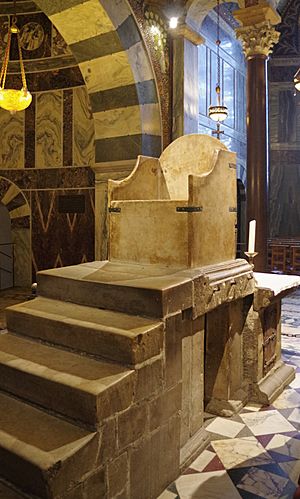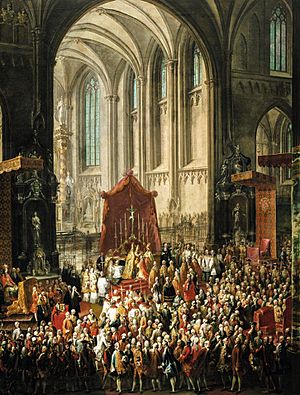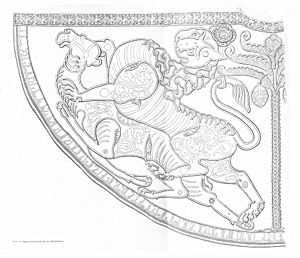King of the Romans facts for kids

The King of the Romans (in Latin, Rex Romanorum; in German, König der Römer) was a special title used in the Holy Roman Empire. It was given to the king of East Francia, which was a large kingdom in what is now Germany. This king was chosen by important leaders called princes.
This title was first used for any German king after he was elected but before he was crowned Holy Roman Emperor by the Pope. It was also used for someone chosen to be the next ruler while the current Emperor was still alive. Later, from the 1500s, German kings started calling themselves "Emperor-elect" and didn't need the Pope to crown them. So, the "King of the Romans" title was then only used for the chosen successor.
The exact name of the title changed over time. In the early days, it was "King of the Franks." Later, it became "King of the Romans." In more recent times, it was sometimes "King in Germania." Today, historians often use "Roman-German King" to show it's different from the old Roman Emperors and the later German Emperors.
Contents
Becoming King of the Romans
How Kings Were Chosen
The area known as East Francia wasn't called the Kingdom of Germany until the 1000s. Around this time, there was a big disagreement between the king and the papacy (the Pope) about who had the right to crown the emperor. This fight was called the Investiture Controversy.
For example, when Henry IV became king at age six in 1056, he used the title Romanorum Rex. This showed he believed he had a special right to be crowned Emperor by the Pope. But Pope Gregory VII sometimes used a less important title, "King of the Germans," to suggest Henry's power was only local. Henry IV kept using Romanorum Rex until he was finally crowned Emperor in 1084. Kings after him did the same. They were called Romanorum Rex before their Roman coronation and Romanorum Imperator afterward.
Medieval Elections and Coronations
To become king, candidates had to be adult men, Catholic Christians, and not priests. They were chosen by important leaders from different parts of the Empire, including princes and bishops. Elections often happened in the city of Frankfurt.
At first, all noblemen could vote. But later, only the most important bishops and noblemen could. By 1356, a special set of rules called the Golden Bull of 1356 was created by Emperor Charles IV. This bull stated that only seven Prince-electors had the right to vote for the king. These seven were:
- The Archbishops of Mainz, Trier, and Cologne.
- The King of Bohemia.
- The Count Palatine of the Rhine.
- The Saxon duke.
- The Margrave of Brandenburg.
After being elected, the new king would be crowned King of the Romans. This usually happened at Aachen Cathedral, on Charlemagne's throne, by the Archbishop of Cologne. This was a very important ceremony. Kings received the Imperial Crown from at least 1024.
After this, if possible, the king would travel across the Alps to be crowned King of Italy in Pavia or Milan. Finally, he would go to Rome to be crowned Emperor by the Pope. It often took many years for a king to complete this journey, and some never made it to Rome at all. The title "King of the Romans" showed that the king had full power over the Empire and was meant to be the future Emperor, without taking away the Pope's special role.
Sometimes, kings couldn't go to Rome because they had problems with the Pope, or because of wars or other duties at home. In these cases, they might remain "King of the Romans" for their entire rule.
Later Changes to the Title

The title "King of the Romans" stopped being used for ruling kings after 1508. That year, Maximilian I was allowed by the Pope to use the title "Elected Emperor of the Romans" because he couldn't travel to Rome for his coronation. Maximilian also started using the title "King in Germania," but this was never his main title.
From Ferdinand I, Holy Roman Emperor onwards, the rulers of the Empire no longer needed the Pope to crown them Emperor. They took the title "Emperor" as soon as they were crowned in Germany, or when the previous Emperor died if they had been crowned during his lifetime.
Kings-in-Waiting
The Holy Roman Empire was an elective monarchy, meaning rulers were chosen by election, not automatically inherited. However, an Emperor could often have a relative, usually a son, elected to take over after his death. This chosen successor was called the "King of the Romans."
In the Middle Ages, a "King of the Romans" (as a successor) was usually chosen only when the main ruler was already an Emperor. This avoided having two kings with equal power. From the 1500s, when rulers started calling themselves "Emperor-elect," the title "King of the Romans" was used only for the chosen successor during the current Emperor's lifetime.
The election for a successor was the same as for the main ruler. However, the Emperor always managed the Empire, with the "King of the Romans" (heir) only taking on certain tasks.
King of Rome (Napoleon's Son)
When Napoleon I, Emperor of the French, had a son, Napoleon II (born in 1811), he created a new title for him: King of Rome (Roi de Rome). His son was known by this title throughout his short life. However, from 1818, he was officially called the Duke of Reichstadt by his grandfather, Emperor Francis I of Austria.
List of Kings of the Romans
This list shows everyone who held the title "King of the Romans." The dates show when they were King of the Romans until they became Emperor, died, or were removed from power.
- Kings who were ruling monarchs are shown in yellow.
- Those whose claim to the throne wasn't widely accepted (called "Anti-kings") are in pink.
- Those who were "Kings of the Romans" only as chosen successors (heirs) are in silver.
- An asterisk (*) means they were elected while their predecessor was still alive.
| King | Kingship begins | Kingship ends | Notes | |
|---|---|---|---|---|
| Henry II | 1002 | 1014 | crowned Emperor | Effective rule: 1002–1024 |
| Conrad II | 1024 | 1027 | crowned Emperor | Effective rule: 1024 – 4 June 1039 |
| Henry III | 1028* | 1046 | crowned Emperor | * elected as son and heir of Emperor Conrad II effective rule: 4 June 1039 – 5 October 1056 |
| Henry IV | 17 July 1054* | 1084 | crowned Emperor | * elected as son and heir of Emperor Henry III effective rule: 5 October 1056 – 31 December 1105 |
| Rudolf of Rheinfelden | 25 May 1077 | 15 October 1080 | killed in battle | Anti-king to Henry IV |
| Hermann of Salm | 6 August 1081 | 28 September 1088 | killed in battle | Anti-king to Henry IV |
| Conrad (III) | 30 May 1087* | 1098 | deposed | * elected as son and heir of Emperor Henry IV rebelled in 1093 and was deposed |
| Henry V | 6 January 1099* | 13 April 1111 | crowned Emperor | * elected as son and heir of Emperor Henry IV rebelled in 1105 and deposed his father effective rule: 31 December 1105 – 23 May 1125 |
| Lothair III | 13 September 1125 | 4 June 1133 | crowned Emperor | Effective rule: 13 September 1125 – 4 December 1137 |
| Conrad III | 1127 | 1135 | renounced claim | Anti-king to Lothair III |
| 7 March 1138 | 15 February 1152 | died | Effective rule: 7 March 1138 — 15 February 1152 | |
| Henry Berengar | 30 March 1147 | 1150 | died | elected as son and heir of King Conrad III, predeased his father |
| Frederick I Barbarossa | 4 March 1152 | 18 June 1155 | crowned Emperor | Effective rule: 4 March 1152 – 10 June 1190 |
| Henry VI | 15 August 1169* | 15 April 1191 | crowned Emperor | * elected as son and heir of Emperor Frederick I effective rule: 10 June 1190 – 28 September 1197 |
| Frederick II | 1196* | 28 September 1197 | claim ignored | * elected as son and heir of Emperor Henry VI |
| Philip of Swabia | 8 March 1198 | 21 June 1208 | murdered | elected in opposition to Otto IV effective rule: 8 March 1198 – 21 June 1208 |
| Otto IV | 9 June 1198 | 21 October 1209 | crowned Emperor | in opposition to Philip until 1208, opposed by Frederick II after 1212 effective rule: 9 June 1198 – 5 July 1215 |
| Frederick II | 5 December 1212 | 22 November 1220 | crowned Emperor | elected in opposition to Otto IV effective rule: 5 July 1215 – 26 December 1250 |
| Henry (VII) | April 1220* | 2 July 1235 | deposed | * elected as son and heir of Emperor Frederick II, later deposed by his father |
| Conrad IV | February 1237* | 21 May 1254 | died | * elected as son and heir of Emperor Frederick II effective rule: 26 December 1250 – 21 May 1254 |
| Henry Raspe | 22 May 1246 | 16 February 1247 | died | Anti-king to Fredrick II |
| William of Holland | 3 October 1247 | 28 January 1256 | died | Anti-king until 21 May 1254 |
| Richard of Cornwall | 13 January 1257 | 2 April 1272 | died | Elected in opposition to Alfonso X of Castile |
| Alfonso X of Castile | 1 April 1257 | 1275 | renounced claim | Elected in opposition to Richard of Cornwall |
| Rudolf I | 29 September 1273 | 15 July 1291 | died | |
| Adolph of Nassau | 5 May 1292 | 2 July 1298 | killed in battle | |
| Albert I | 24 June 1298 | 1 May 1308 | murdered | Originally elected in opposition to Adolf of Nassau Effective rule: 2 July 1298 – 1 May 1308 |
| Henry VII | 27 November 1308 | 29 June 1312 | crowned Emperor | Effective rule: 27 November 1308 – 24 August 1313 |
| Louis IV | 20 October 1314 | 17 January 1328 | crowned Emperor | Elected in opposition to Frederick the Fair Effective rule: 20 October 1314 – 11 October 1347 |
| Frederick the Fair | 19 October 1314 | 28 September 1322 | captured | Elected in opposition to Louis IV |
| 5 September 1325 | 3 January 1330 | died | Ruled jointly with Louis IV | |
| Charles IV | 11 July 1346 | 5 April 1355 | crowned Emperor | Originally elected in opposition to Louis IV Effective rule: 11 July 1346 – 29 November 1378 |
| Günther von Schwarzburg | 30 January 1349 | 24 May 1349 | died | Elected in opposition to Charles IV |
| Wenceslaus | 10 June 1376* | 20 August 1400 | deposed | * elected as son and heir of Emperor Charles IV Effective rule: 29 November 1378 – 20 August 1400 |
| Rupert of Palatinate | 21 August 1400 | 18 May 1410 | died | |
| Sigismund | 10 September 1410 21 July 1411 |
3 May 1433 | crowned Emperor | Elected in opposition to Jobst of Moravia, then unanimously elected again effective rule: 10 September 1410 – 9 December 1437 |
| Jobst of Moravia | 1 October 1410 | 8 January 1411 | died | Elected in opposition to Sigismund |
| Albert II | 18 March 1438 | 27 October 1439 | died | |
| Frederick III | 2 February 1440 | 16 March 1452 | crowned Emperor | Effective rule: 2 February 1440 – 19 August 1493 |
| Maximilian I | 16 February 1486* | 4 February 1508 | assumed title of Emperor elect | * elected as son and heir of Emperor Frederick III Effective rule: 19 August 1493 – 12 January 1519 introduced the title Rex in Germania. |
| Ferdinand I | 5 January 1531* | 27 August 1556 | succeeded as Emperor elect | * elected as brother and heir of Emperor Charles V Effective rule: 27 August 1556 – 25 July 1564 |
| Maximilian II | 28 November 1562* | 25 July 1564 | succeeded as Emperor elect | * elected as son and heir of Emperor Ferdinand I Effective rule: 25 July 1564 – 12 October 1576 |
| Rudolph II | 27 October 1575* | 12 October 1576 | succeeded as Emperor elect | * elected as son and heir of Emperor Maximilian II Effective rule: 12 October 1576 – 20 January 1612 |
| Ferdinand III | 22 December 1636* | 15 February 1637 | succeeded as Emperor elect | * elected as son and heir of Emperor Ferdinand II Effective rule: 15 February 1637 – 2 April 1657 |
| Ferdinand IV | 31 May 1653 | 9 July 1654 | died | * elected as son and heir of Emperor Ferdinand III, predeceased his father |
| Joseph I | 23 January 1690 | 5 May 1705 | succeeded as Emperor elect | * elected as son and heir of Emperor Leopold I Effective rule: 5 May 1705 – 17 April 1711 |
| Joseph II | 27 March 1764 | 18 August 1765 | succeeded as Emperor elect | * elected as son and heir of Emperor Francis I Effective rule: 18 August 1765 – 20 February 1790 |
See also
- List of German monarchs, rulers of the Holy Roman Empire and Germany, including those using titles other than "King of the Romans"
- List of Holy Roman Emperors



